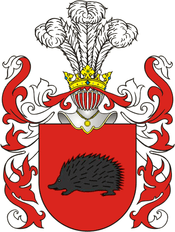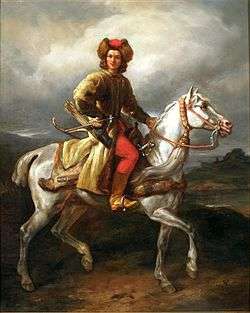Aleksander Józef Lisowski


Aleksander Józef Lisowski HNG (c. 1580 – October 11, 1616) was a Polish–Lithuanian noble (szlachcic), commander of a mercenary group that after his death adopted the name "Lisowczycy." His coat of arms was Jeż (Hedgehog). Little is known about his childhood, except that his family moved to Grand Duchy of Lithuania (then a part of the Polish–Lithuanian Commonwealth) sometime mid-16th century. First references of Aleksander Józef Lisowski put him in 1601 involved with the Moldavian Magnate Wars, first as a supporter of Mihai Viteazul (Polish: Michał Waleczny), later as a supporter of kanclerz Jan Zamoyski.
In 1604, during the early stages of the Polish–Swedish War, the Sejm of Commonwealth failed to gather money to pay its soldiers fighting in Livonia against the Swedes. Aleksander Józef Lisowski became one of the leaders of the resulting konfederacja – a mutinied part of the army, that decided to gather their wages by pillaging local civilians, not caring whether they pledged allegiance to Poland or Sweden. Although this annoyed the Polish commander, hetman Jan Karol Chodkiewicz, and resulted in the banicja sentence on Lisowski, little was done to stop the mutinied forces. Soon Lisowski with his followers joined the rokosz of Zebrzydowski, a larger rebellion against the Commonwealth Sigismund III Vasa.
Eventually, after the rokosz forces were defeated in the battle of Guzow, Lisowski's fortunes turned low and he became persona non grata in most of the Commonwealth and sought refugee with the powerful magnate family of Radziwiłłs. It was the Muscovy's Time of Troubles and Lisowski could not pass the opportunity to try to make a profit out of this, as many other local magnates and szlachta already did, meddling in the Muscovy affairs. Soon afterwards he decided to support the pretender to the Muscovy throne, False Dmitriy II.
In 1608 together with Aleksander Kleczkowski, leading his forces – a band of few hundred rag tag soldiers of fortune: Don Cossacks, Ruthenians, Tatars, Germans, Swedes, Poles, Lithuanians and who knows what others, he defeated army of tsar Vasili Shuisky led by Zakhary Lyapunov and Ivan Khovansky near Zaraysk and captures Mikhaylov and Kolomna and moves on to the blockade of Moscow. Soon however he is defeated at Niedźwiedzi Bród, losing most of his loot. He reorganized the army and joined with Jan Piotr Sapieha, but they failed to capture the Troitse-Sergieva Lavra fortress and were forced to retreated near Rakhmantsevo. Then came successes (pillages) at Kostroma, Soligalich and some other cities (those battles took place around 1608–09). He took Pskov in 1610 and clashed with Swedes operating in Muscovy during the Ingrian War. Lisowczycy were essential in the defence of Smolensk in 1612, when most of regulars (wojsko kwarciane) mutinied and joined the konfederacja rohatynska. For the next three years Lisowski's forces were important in the guarding of the Polish-Muscovy border against Muscovy incursions. In 1615 Lisowski gathered many outlaws and invaded Muscovy with 6 'choragiew' of cavalry. He lied siege to Bryansk and defeated the relief force of a few thousand soldiers under kniaz Yuri Shakhovskoy near Karachev. Then Lisowski defeated the front guard of a much larger force (several times larger than himself) under the command of knyaz Dmitry Pozharsky, who decided to defend instead of attack and fortified his forces in a camp. Lisowczycy broke contact with his forces, burned Belyov and Likhvin, took Peremyshl, turned north, defeated Muscovy army at Rzhev, turned to Kara Sea, then to Kashin, burned Torzhok, returned to Poland without any interference from Muscovite forces. Until the autumn of 1616, Lisowski and his forces remained at the Polish-Muscovite border, when Lisowski suddenly fell ill and died. In his memory, his men adopted the name, Lisowczycy ("Lisowski's men").